Heterobimetallic Ru(II)/M (M = Ag+, Cu2+, Pb2+) Complexes as Photosensitizers for Room-Temperature Gas Sensing
Abstract
:1. Introduction
2. Results and Discussion
3. Materials and Methods
3.1. Materials Synthesis
3.1.1. Synthesis of Nanocrystalline In2O3
3.1.2. Synthesis of Heterobimetallic Ru(II) Complexes
3.1.3. Synthesis of Hybrid Materials
3.2. Materials Characterization
4. Conclusions
Supplementary Materials
Author Contributions
Funding
Institutional Review Board Statement
Informed Consent Statement
Data Availability Statement
Acknowledgments
Conflicts of Interest
Sample Availability
References
- World Health Organization (WHO). WHO Guidelines for Indoor Air Quality: Selected Pollutants. Available online: www.euro.who.int_data/assets/pdf_file/0009/128169/e94535/pdf (accessed on 20 November 2019).
- Rasmussen, R.E.; Mannix, R.C.; Oldham, M.J.; Phalen, R.F. Effects of nitrogen dioxide on respiratory tract clearance in the ferret. J. Toxicol. Environ. Health 1994, 41, 109–120. [Google Scholar] [CrossRef] [PubMed] [Green Version]
- Witschi, H. Ozone, nitrogen dioxide and lung cancer: A review of some recent issues and problems. Toxicology 1988, 48, 1–20. [Google Scholar] [CrossRef]
- Morgenstern, V.; Zutavern, A.; Cyrys, J.; Brockow, I.; Koletzko, S.; Krämer, U.; Behrendt, H.; Herbarth, O.; Berg, A.; Bauer, C.P.; et al. Atopic diseases, allergic sensitization, and exposure to traffic-related air pollution in children. Am. J. Respir. Crit. Care Med. 2008, 177, 1331–1337. [Google Scholar] [CrossRef] [PubMed]
- Ammonia. Health and Safety Guide Nº37. IPCS International Programme on Chemical Safety; World Health Organization: Geneva, Switzerland, 1990. [Google Scholar]
- Smeets, M.A.M.; Bulsing, P.J.; van Rooden, S.; Steinmann, R.; de Ru, J.A.; Ogink, N.W.M.; van Thriel, C.; Dalton, P.H. Odor and Irritation Thresholds for Ammonia: A Comparison between Static and Dynamic Olfactometry. Chem. Senses 2007, 32, 11–20. [Google Scholar] [CrossRef] [Green Version]
- Recommendation from the Scientific Committee on Occupational Exposure Limits for Nitrogen Dioxide. SCOEL/SUM/53 June 2014. Available online: https://ec.europa.eu/social/BlobServlet?docId=12431&langId=en (accessed on 11 June 2014).
- Air Quality Guidelines for Europe, 2nd ed.; World Health Organization, Regional Office for Europe: Geneva, Switzerland, 2000; Available online: https://apps.who.int/iris/handle/10665/107335 (accessed on 16 November 2021).
- National Academies of Sciences, Engineering, and Medicine. Emergency and Continuous Exposure Guidance Levels for Selected Submarine Contaminants: Volume 1; The National Academies Press: Washington, DC, USA, 2007. [Google Scholar] [CrossRef]
- Marshall, B.M. COVID’s Toll on Smell and Taste: What scientists do and don’t know. Nature 2021, 589, 342–343. [Google Scholar] [CrossRef]
- Jiang, K. How COVID-19 Causes Loss of Smell. Available online: https://hms.harvard.edu/news/how-covid-19-causes-loss-smell (accessed on 24 July 2020).
- Shelton, J.F.; Shastri, A.J.; Fletez-Brant, K.; Auton, A.; Chubb, A.; Fitch, A.; Kung, A.; Altman, A.; Kill, A.; Shastri, A.J.; et al. The UGT2A1/UGT2A2 Locus Is Associated with COVID-19-Related Loss of Smell or Taste. Nat. Genet. 2022, 54, 121–124. [Google Scholar] [CrossRef]
- Exline, M.C.; Stanacevic, M.; Bowman, A.S.; Gouma, P.I. Exhaled nitric oxide detection for diagnosis of COVID-19 in critically ill patients. PLoS ONE 2021, 16, e0257644. [Google Scholar] [CrossRef]
- Korotcenkov, G. Handbook of Gas Sensor Materials; Springer: Gwangju, South Korea, 2014; Volume 2, ISBN 9781461473879. [Google Scholar]
- Das, S.; Mojumder, S.; Saha, D.; Pal, M. Influence of Major Parameters on the Sensing Mechanism of Semiconductor Metal Oxide Based Chemiresistive Gas Sensors: A Review Focused on Personalized Healthcare. Sens. Actuators B Chem. 2022, 352, 131066. [Google Scholar] [CrossRef]
- Yamazoe, N.; Sakai, G.; Shimanoe, K. Oxide Semiconductor Gas Sensors. Catal. Surv. from Asia 2003, 7, 63–75. [Google Scholar] [CrossRef]
- Korotcenkov, G. Metal Oxides for Solid-State Gas Sensors: What Determines Our Choice? Mater. Sci. Eng. B Solid-State Mater. Adv. Technol. 2007, 139, 1–23. [Google Scholar] [CrossRef]
- Barsan, N.; Koziej, D.; Weimar, U. Metal Oxide-Based Gas Sensor Research: How To? Sens. Actuators B Chem. 2007, 121, 18–35. [Google Scholar] [CrossRef]
- Bierwagen, O. Indium Oxide—A Transparent, Wide-Band Gap Semiconductor for (Opto)Electronic Applications. Semicond. Sci. Technol. 2015, 30, 24001. [Google Scholar] [CrossRef]
- Wang, C.Y.; Cimalla, V.; Kups, T.; Röhlig, C.C.; Stauden, T.; Ambacher, O.; Kunzer, M.; Passow, T.; Schirmacher, W.; Pletschen, W.; et al. Integration of In2O3 Nanoparticle Based Ozone Sensors with GaInNGaN Light Emitting Diodes. Appl. Phys. Lett. 2007, 91, 103509. [Google Scholar] [CrossRef]
- Rumyantseva, M.; Nasriddinov, A.; Vladimirova, S.; Tokarev, S.; Fedorova, O.; Krylov, I.; Drozdov, K.; Baranchikov, A.; Gaskov, A. Photosensitive Organic-Inorganic Hybrid Materials for Room Temperature Gas Sensor Applications. Nanomaterials 2018, 8, 671. [Google Scholar] [CrossRef] [Green Version]
- Nasriddinov, A.; Rumyantseva, M.; Shatalova, T.; Tokarev, S.; Yaltseva, P.; Fedorova, O.; Khmelevsky, N.; Gaskov, A. Organic-Inorganic Hybrid Materials for Room Temperature Light-Activated Sub-Ppm No Detection. Nanomaterials 2019, 10, 70. [Google Scholar] [CrossRef] [PubMed] [Green Version]
- Nasriddinov, A.; Tokarev, S.; Fedorova, O.; Bozhev, I.; Rumyantseva, M. In2O3 Based Hybrid Materials: Interplay between Microstructure, Photoelectrical and Light Activated NO2 Sensor Properties. Chemosensors 2022, 10, 135. [Google Scholar] [CrossRef]
- Zhu, L.; Wang, J.; Liu, J.; Xu, Z.; Nasir, M.S.; Chen, X.; Wang, Z.; Sun, S.; Ma, Q.; Liu, J.; et al. In situ enrichment amplification strategy enabling highly sensitive formaldehyde gas sensor. Sens. Actuators B Chem. 2022, 354, 131206. [Google Scholar] [CrossRef]
- Liu, Z.; He, T.; Sun, H.; Huang, B.; Li, X. Layered MXene heterostructured with In2O3 nanoparticles for ammonia sensors at room temperature. Sens. Actuators B Chem. 2022, 365, 131918. [Google Scholar] [CrossRef]
- Zhou, M.; Han, Y.; Yao, Y.; Xie, L.; Zhao, X.; Wang, J.; Zhu, Z. Fabrication of Ti3C2Tx/In2O3 nanocomposites for enhanced ammonia sensing at room temperature. Ceram. Int. 2022, 48, 6600–6607. [Google Scholar] [CrossRef]
- Gu, F.; Nie, R.; Han, D.; Wang, Z. In2O3–graphene nanocomposite based gas sensor for selective detection of NO2 at room temperature. Sens. Actuators B 2015, 219, 94–99. [Google Scholar] [CrossRef]
- Liang, X.; Chen, Z.; Wu, H.; Guo, L.; He, C.; Wang, B.; Wu, Y. Enhanced NH3-Sensing Behavior of 2,9,16, 23-Tetrakis(2,2,3,3-Tetrafluoropropoxy) Metal(II) Phthalocyanine/Multi-Walled Carbon Nanotube Hybrids: An Investigation of the Effects of Central Metals. Carbon N. Y. 2014, 80, 268–278. [Google Scholar] [CrossRef]
- Huang, J.; Jiang, D.; Zhou, J.; Ye, J.; Sun, Y.; Li, X.; Geng, Y.; Wang, J.; Du, Y.; Qian, Z. Visible Light-Activated Room Temperature NH3 Sensor Base on CuPc-Loaded ZnO Nanorods. Sens. Actuators B Chem. 2021, 327, 128911. [Google Scholar] [CrossRef]
- Patil, U.V.; Ramgir, N.S.; Karmakar, N.; Bhogale, A.; Debnath, A.K.; Aswal, D.K.; Gupta, S.K.; Kothari, D.C. Room Temperature Ammonia Sensor Based on Copper Nanoparticleintercalated Polyaniline Nanocomposite Thin Films. Appl. Surf. Sci. 2015, 339, 69–74. [Google Scholar] [CrossRef]
- Rumyantseva, M.; Makeeva, E.; Gaskov, A.; Shepel, N.; Peregudova, S.; Khoroshutin, A.; Tokarev, S.; Fedorova, O. H2S Sensing by Hybrids Based on Nanocrystalline SnO2 Functionalized with Cu(II) Organometallic Complexes: The Role of the Ligand Platform. Nanomaterials 2017, 7, 384. [Google Scholar] [CrossRef] [PubMed] [Green Version]
- Goncharov, T.; Nasriddinov, A.; Zubenko, A.; Tokarev, S.; Shatalova, T.; Khmelevsky, N.; Fedorova, O.; Rumyantseva, M. Nanocrystalline SnO2 Functionalized with Ag(I) Organometallic Complexes as Materials for Low Temperature H2S Detection. Materials 2021, 14, 7778. [Google Scholar] [CrossRef]
- Tokarev, S.D.; Botezatu, A.; Fedorov, Y.V.; Fedorova, O.A. New Heterobimetallic Ruthenium(II) Complex with Imidazo [4,5-f][1,10]Phenanthroline-Based Ligand: Synthesis, Optical and Electrochemical Properties. Chem. Heterocycl. Compd. 2021, 57, 799–805. [Google Scholar] [CrossRef]
- Munshi, M.U.; Martens, J.; Berden, G.; Oomens, J. Vibrational Spectra of the Ruthenium-Tris-Bipyridine Dication and Its Reduced Form in Vacuo. J. Phys. Chem. A 2020, 124, 2449–2459. [Google Scholar] [CrossRef] [Green Version]
- Mukaida, M. The ruthenium complexes formed by the reactions of nitrosyl-ruthenium(III) with tin(II) in hydrochloric acid solution. Bull. Chem. Soc. Jpn. 1970, 43, 3805–3813. [Google Scholar] [CrossRef] [Green Version]
- Adeniyi, A.A.; Ajibade, P.A. Exploring the Ruthenium-Ligands Bond and Their Relative Properties at Different Computational Methods. J. Chem. 2016, 2016. [Google Scholar] [CrossRef] [Green Version]
- Socrates, G. Infrared and Raman Characteristic Group Frequencies: Tables and Charts, 3rd ed.; John Wiley & Sons Ltd.: West Sussex, UK, 2001. [Google Scholar]
- Ioachim, E.; Medlycott, E.A.; Hanan, G.S.; Loiseau, F.; Campagna, S. Synthesis and Properties of Red Emitter Ru(II) Complexes Based on 6,6′-Disubstituted-4,4′-Bipyrimidine. Inorganica Chim. Acta 2006, 359, 766–774. [Google Scholar] [CrossRef]
- Zhang, Y.; Xu, P.; Xu, J.; Li, H.; Ma, W. NH3 Sensing Mechanism Investigation of CuBr: Different Complex Interactions of the Cu+ Ion with NH3 and O2 Molecules. J. Phys. Chem. C 2011, 115, 2014–2019. [Google Scholar] [CrossRef]
- Centi, G.; Perathoner, S. Nature of Active Species in Copper-Based Catalysts and Their Chemistry of Transformation of Nitrogen Oxides. Appl. Catal. A Gen. 1995, 132, 179–259. [Google Scholar] [CrossRef]
- Deka, U.; Juhin, A.; Eilertsen, E.A.; Emerich, H.; Green, M.A.; Korhonen, S.T.; Weckhuysen, B.M.; Beale, A.M. Confirmation of Isolated Cu2+ Ions in SSZ-13 Zeolite as Active Sites in NH 3-Selective Catalytic Reduction. J. Phys. Chem. C 2012, 116, 4809–4818. [Google Scholar] [CrossRef]
- Lezcano-Gonzalez, I.; Deka, U.; Arstad, B.; Van Yperen-De Deyne, A.; Hemelsoet, K.; Waroquier, M.; Van Speybroeck, V.; Weckhuysen, B.M.; Beale, A.M. Determining the Storage, Availability and Reactivity of NH3 within Cu-Chabazite-Based Ammonia Selective Catalytic Reduction Systems. Phys. Chem. Chem. Phys. 2014, 16, 1639–1650. [Google Scholar] [CrossRef] [PubMed]
- Chen, P.; Simböck, J.; Schönebaum, S.; Rauch, D.; Simons, T.; Palkovits, R.; Moos, R.; Simon, U. Monitoring NH3 Storage and Conversion in Cu-ZSM-5 and Cu-SAPO-34 Catalysts for NH3-SCR by Simultaneous Impedance and DRIFT Spectroscopy. Sens. Actuators B Chem. 2016, 236, 1075–1082. [Google Scholar] [CrossRef]
- Basova, T.V.; Mikhaleva, N.S.; Hassan, A.K.; Kiselev, V.G. Thin Films of Fluorinated 3d-Metal Phthalocyanines as Chemical Sensors of Ammonia: An Optical Spectroscopy Study. Sens. Actuators B Chem. 2016, 227, 634–642. [Google Scholar] [CrossRef]
- Lei, H.; Rizzotto, V.; Guo, A.; Ye, D.; Simon, U.; Chen, P. Recent Understanding of Low-Temperature Copper Dynamics in Cu-Chabazite NH3-SCR Catalysts. Catalysts 2021, 11, 52. [Google Scholar] [CrossRef]
- Sharma, N.; Sharma, N.; Srinivasan, P.; Kumar, S.; Rayappan, J.B.B.; Kailasam, K. Heptazine based organic framework as a chemiresistive sensor for ammonia detection at room temperature. J. Mater. Chem. A 2018, 6, 18389. [Google Scholar] [CrossRef]
- Albrecht, E.; Baum, G.; Bellunato, T.; Bressan, A.; Torre, S.D.; D’Ambrosio, C.; Davenport, M.; Dragicevic, M.; Pinto, S.D.; Fauland, P.; et al. VUV Absorbing Vapours in n-Perfluorocarbons. Nucl. Instruments Methods Phys. Res. Sect. A Accel. Spectrometers, Detect. Assoc. Equip. 2003, 510, 262–272. [Google Scholar] [CrossRef] [Green Version]
- Sircar, S.; Myers, A.L. Gas Separation by Zeolites in Handbook of Zeolites Science and Technology; Chapter 22; Auerbach, S.M., Carrado, K.A., Dutta, P.K., Eds.; Marcel Dekker, Inc.: New York, NY, USA, 2003. [Google Scholar]
- Can, I.; Weimar, U.; Barsan, N. Operando Investigations of Differently Prepared In2O3-Gas Sensors. Multidiscip. Digit. Publ. Inst. Proc. 2017, 1, 432. [Google Scholar]
- Heiland, G.; Kohl, D. Physical and Chemical Aspects of Oxidic Semiconductor Gas Sensors. In Chemical Sensor Technology; Chapter 2; Seiyama, T., Ed.; Elsevier Science: Amsterdam, The Netherlands, 1988; Volume 1, pp. 15–38. [Google Scholar]
- Nasriddinov, A.; Rumyantseva, M.; Konstantinova, E.; Marikutsa, A.; Tokarev, S.; Yaltseva, P.; Fedorova, O.; Gaskov, A. Effect of Humidity on Light-Activated NO and NO2 Gas Sensing by Hybrid Materials. Nanomaterials 2020, 10, 915. [Google Scholar] [CrossRef]
- Liu, X.L.; Ma, S.X.; Zhu, S.W.; Zhao, Y.; Ning, X.J.; Zhao, L. Light stimulated and regulated gas sensing ability for ammonia using sulfur-hyperdoped silicon. Sens. Actuators B Chem. 2019, 291, 345–353. [Google Scholar] [CrossRef]
- Gonzalez, O.; Welearegay, T.G.; Vilanova, X.; Llobet, E. Using the Transient Response of WO3 Nanoneedles under Pulsed UV Light in the Detection of NH3 and NO2. Sensors 2018, 18, 1346. [Google Scholar] [CrossRef] [PubMed] [Green Version]
- Gu, D.; Li, X.; Wang, H.; Li, M.; Xi, Y.; Chen, Y.; Wang, J.; Rumyantseva, M.N.; Gaskov, A.M. Light enhanced VOCs sensing of WS2 microflakes based chemiresistive sensors powered by triboelectronic nangenerators. Sens. Actuators B Chem. 2018, 256, 992–1000. [Google Scholar] [CrossRef]
- Yang, Y.; Yu, S.; Guo, J.; Zhang, D. UV-enhanced highly sensitive ammonia sensing properties based on 2DPI/In2O3 heterostructure at room temperature. J. Alloys Compd. 2022, 920, 165878. [Google Scholar] [CrossRef]
- Hong, L.Y.; Lin, H.N. NO gas sensing at room temperature using single titanium oxide nanodot sensors created by atomic force microscopy nanolithography. Beilstein J. Nanotechnol. 2016, 7, 1044–1051. [Google Scholar] [CrossRef] [Green Version]
- Gogurla, N.; Sinha, A.K.; Santra, S.; Manna, S.; Ray, S.K. Multifunctional Au-ZnO Plasmonic Nanostructures for Enhanced UV Photodetector and Room Temperature NO Sensing Devices. Sci. Rep. 2014, 4, 6483. [Google Scholar] [CrossRef] [Green Version]
- Chinh, N.D.; Quang, N.D.; Lee, H.; Hien, T.T.; Hieu, N.M.; Kim, D.; Kim, C.; Kim, D. NO gas sensing kinetics at room temperature under UV light irradiation of In2O3 nanostructures. Sci. Rep. 2016, 6, 35066. [Google Scholar] [CrossRef] [Green Version]
- Madhaiyan, G.; Tung, T.W.; Zan, H.W.; Meng, H.F.; Lu, C.J.; Ansari, A.; Chuang, W.T.; Lin, H.C. UV-enhanced room-temperature ultrasensitive NO gas sensor with vertical channel nano-porous organic diodes. Sens. Actuators B. Chem. 2020, 320, 128392. [Google Scholar] [CrossRef]
- Wagner, T.; Kohl, C.D.; Malagù, C.; Donato, N.; Latino, M.; Neri, G.; Tiemann, M. UV Light-Enhanced NO2 Sensing by Mesoporous In2O3: Interpretation of Results by a New Sensing Model. Sens. Actuators B Chem. 2013, 187, 488–494. [Google Scholar] [CrossRef]
- Ilin, A.; Martyshov, M.; Forsh, E.; Forsh, P.; Rumyantseva, M.; Abakumov, A.; Gaskov, A.; Kashkarov, P. UV Effect on NO2 Sensing Properties of Nanocrystalline In2O3. Sens. Actuators B Chem. 2016, 231, 491–496. [Google Scholar] [CrossRef]
- Zhang, C.; Boudiba, A.; De Marco, P.; Snyders, R.; Olivier, M.G.; Debliquy, M. Room Temperature Responses of Visible-Light Illuminated WO3 Sensors to NO2 in Sub-Ppm Range. Sens. Actuators B Chem. 2013, 181, 395–401. [Google Scholar] [CrossRef]
- Mun, Y.; Park, S.; An, S.; Lee, C.; Kim, H.W. NO2 Gas Sensing Properties of Au-Functionalized Porous ZnO Nanosheets Enhanced by UV Irradiation. Ceram. Int. 2013, 39, 8615–8622. [Google Scholar] [CrossRef]
- Karaduman, I.; Yildiz, D.E.; Sincar, M.M.; Acar, S. UV Light Activated Gas Sensor for NO2 Detection. Mater. Sci. Semicond. Process. 2014, 28, 43–47. [Google Scholar] [CrossRef]
- Park, S.; Kim, S.; Ko, H.; Lee, C. Light-Enhanced Gas Sensing of ZnS-Core/ZnO-Shell Nanowires at Room Temperature. J. Electroceramics 2014, 33, 75–81. [Google Scholar] [CrossRef]
- Park, S.; Ko, H.; Lee, S.; Kim, H.; Lee, C. Light-Activated Gas Sensing of Bi2O3-Core/ZnO-Shell Nanobelt Gas Sensors. Thin Solid Film. 2014, 570, 298–302. [Google Scholar] [CrossRef]
- Zhang, C.; Wang, J.; Olivier, M.G.; Debliquy, M. Room Temperature Nitrogen Dioxide Sensors Based on N719-Dye Sensitized Amorphous Zinc Oxide Sensors Performed under Visible-Light Illumination. Sens. Actuators B Chem. 2015, 209, 69–77. [Google Scholar] [CrossRef]
- Park, S.; Sun, G.J.; Kheel, H.; Ko, T.; Kim, H.W.; Lee, C. Light-Activated NO2 Gas Sensing of the Networked CuO-Decorated ZnS Nanowire Gas Sensor. Appl. Phys. A Mater. Sci. Process. 2016, 122, 1–8. [Google Scholar] [CrossRef]
- Chizhov, A.; Rumyantseva, M.; Vasiliev, R.; Filatova, D.; Drozdov, K.; Krylov, I.; Marchevsky, A.; Karakulina, O.; Abakumov, A.; Gaskov, A. Visible light activation of room temperature NO2 gas sensors based on ZnO, SnO2 and In2O3 sensitized with CdSe quantum dots. Thin Solid Film. 2016, 618, 253–262. [Google Scholar] [CrossRef]
- Chizhov, A.S.; Rumyantseva, M.N.; Vasiliev, R.B.; Filatova, D.G.; Drozdov, K.A.; Krylov, I.V.; Abakumov, A.M.; Gaskov, A.M. Visible Light Activated Room Temperature Gas Sensors Based on Nanocrystalline ZnO Sensitized with CdSe Quantum Dots. Sens. Actuators B Chem. 2014, 205, 305–312. [Google Scholar] [CrossRef]
- Espid, E.; Taghipour, F. Development of Highly Sensitive ZnO/In2O3 Composite Gas Sensor Activated by UV-LED. Sens. Actuators B Chem. 2017, 241, 828–839. [Google Scholar] [CrossRef]
- Zhou, Y.; Zou, C.; Lin, X.; Guo, Y. UV Light Activated NO2 Gas Sensing Based on Au Nanoparticles Decorated Few-Layer MoS2 Thin Film at Room Temperature. Appl. Phys. Lett. 2018, 113, 2–7. [Google Scholar] [CrossRef]
- Casals, O.; Markiewicz, N.; Fabrega, C.; Gràcia, I.; Cane, C.; Wasisto, H.S.; Waag, A.; Prades, J.D. A Parts per Billion (Ppb) Sensor for NO2 with Microwatt (ΜW) Power Requirements Based on Micro Light Plates. ACS Sens. 2019, 4, 822–826. [Google Scholar] [CrossRef] [PubMed] [Green Version]
- Paolucci, V.; Emamjomeh, S.M.; Ottaviano, L.; Cantalini, C. Near Room Temperature Light-Activated WS2-Decorated RGo as NO2 Gas Sensor. Sensors 2019, 19, 2617. [Google Scholar] [CrossRef] [Green Version]
- Chizhov, A.; Vasiliev, R.; Rumyantseva, M.; Krylov, I.; Drozdov, K.; Batuk, M.; Hadermann, J.; Abakumov, A.; Gaskov, A. Light-activated sub-ppm NO2 detection by hybrid ZnO/QD nanomaterials vs. charge localization in core-shell QD. Front. Mater. 2019, 6, 1–14. [Google Scholar] [CrossRef] [Green Version]
- Espid, E.; Noce, A.S.; Taghipour, F. The Effect of Radiation Parameters on the Performance of Photo-Activated Gas Sensors. J. Photochem. Photobiol. A Chem. 2019, 374, 95–105. [Google Scholar] [CrossRef]
- Tian, X.; Yang, X.; Yang, F.; Qi, T. A Visible-Light Activated Gas Sensor Based on Perylenediimide-Sensitized SnO2 for NO2 Detection at Room Temperature. Colloids Surfaces A Physicochem. Eng. Asp. 2019, 578, 123621. [Google Scholar] [CrossRef]
- Feng, C.; Wen, F.; Ying, Z.; Li, L.; Zheng, X.; Zheng, P.; Wang, G. Polypeptide-Assisted Hydrothermal Synthesis of ZnO for Room Temperature NO2 Gas Sensor under UV Illumination. Chem. Phys. Lett. 2020, 754, 137745. [Google Scholar] [CrossRef]
- Chen, C.; Zhang, Q.; Xie, G.; Yao, M.; Pan, H.; Du, H.; Tai, H.; Du, X.; Su, Y. Enhancing Visible Light-Activated NO2 Sensing Properties of Au NPs Decorated ZnO Nanorods by Localized Surface Plasmon Resonance and Oxygen Vacancies. Mater. Res. Express 2020, 7, 015924. [Google Scholar] [CrossRef]
- Zhang, Q.; Xie, G.; Xu, M.; Su, Y.; Tai, H.; Du, H.; Jiang, Y. Visible Light-Assisted Room Temperature Gas Sensing with ZnO-Ag Heterostructure Nanoparticles. Sens. Actuators B Chem. 2018, 259, 269–281. [Google Scholar] [CrossRef]
- Kumar, R.R.; Murugesan, T.; Dash, A.; Hsu, C.H.; Gupta, S.; Manikandan, A.; Anbalagan, A.K.; Lee, C.H.; Tai, N.H.; Chueh, Y.L.; et al. Ultrasensitive and Light-Activated NO2 Gas Sensor Based on Networked MoS2/ZnO Nanohybrid with Adsorption/Desorption Kinetics Study. Appl. Surf. Sci. 2021, 536, 147933. [Google Scholar] [CrossRef]
- Chizhov, A.S.; Rumyantseva, M.N.; Drozdov, K.A.; Krylov, I.V.; Batuk, M.; Hadermann, J.; Filatova, D.G.; Khmelevsky, N.O.; Kozlovsky, V.F.; Maltseva, L.N.; et al. Photoresistive gas sensor based on nanocrystalline ZnO sensitized with colloidal perovskite CsPbBr3 nanocrystals. Sens. Actuators B Chem. 2021, 329, 129035. [Google Scholar] [CrossRef]
- Liu, Y.; Zhang, J.; Li, G.; Liu, J.; Liang, Q.; Wang, H.; Zhu, Y.; Gao, J.; Lu, H. In2O3–ZnO Nanotubes for the Sensitive and Selective Detection of Ppb-Level NO2 under UV Irradiation at Room Temperature. Sens. Actuators B Chem. 2022, 355, 131322. [Google Scholar] [CrossRef]
- Batista, R.M.F.; Costa, S.P.G.; Belsley, M.; Lodeiro, C.; Raposo, M.M.M. Synthesis and Characterization of Novel (Oligo)Thienyl-Imidazo-Phenanthrolines as Versatile π-Conjugated Systems for Several Optical Applications. Tetrahedron 2008, 64, 9230–9238. [Google Scholar] [CrossRef] [Green Version]
- Fedorova, O.A.; Shepel, N.E.; Tokarev, S.D.; Lukovskaya, E.V.; Sotnikova, Y.A.; Moiseeva, A.A.; D’Aléo, A.; Fages, F.; Maurel, F.; Fedorov, Y.V. Intramolecular Electron Transfer in Cu(II) Complexes with Aryl-Imidazo-1,10-Phenanthroline Derivatives: Experimental and Quantum Chemical Calculation Studies. New J. Chem. 2019, 43, 2817–2827. [Google Scholar] [CrossRef]

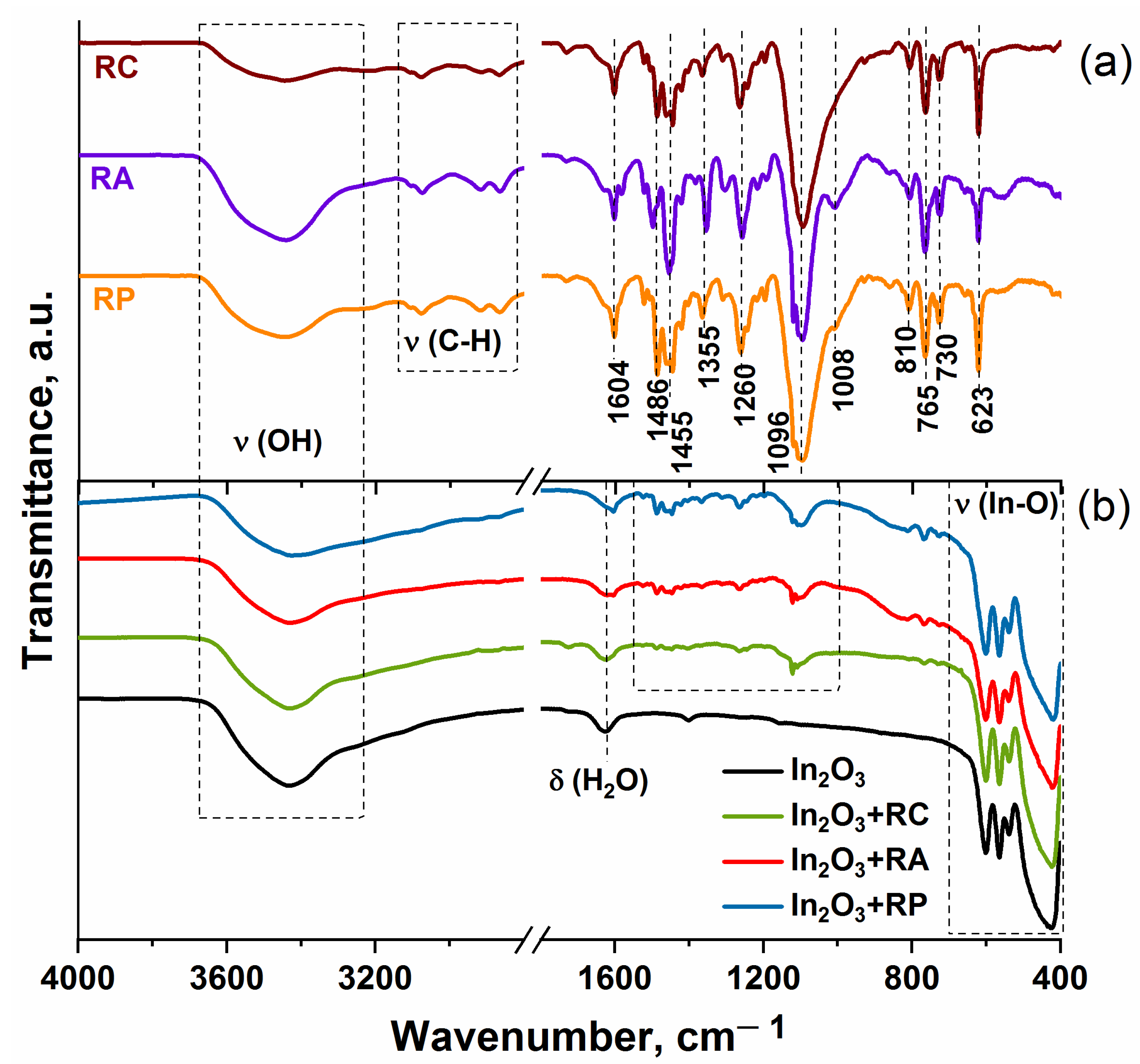
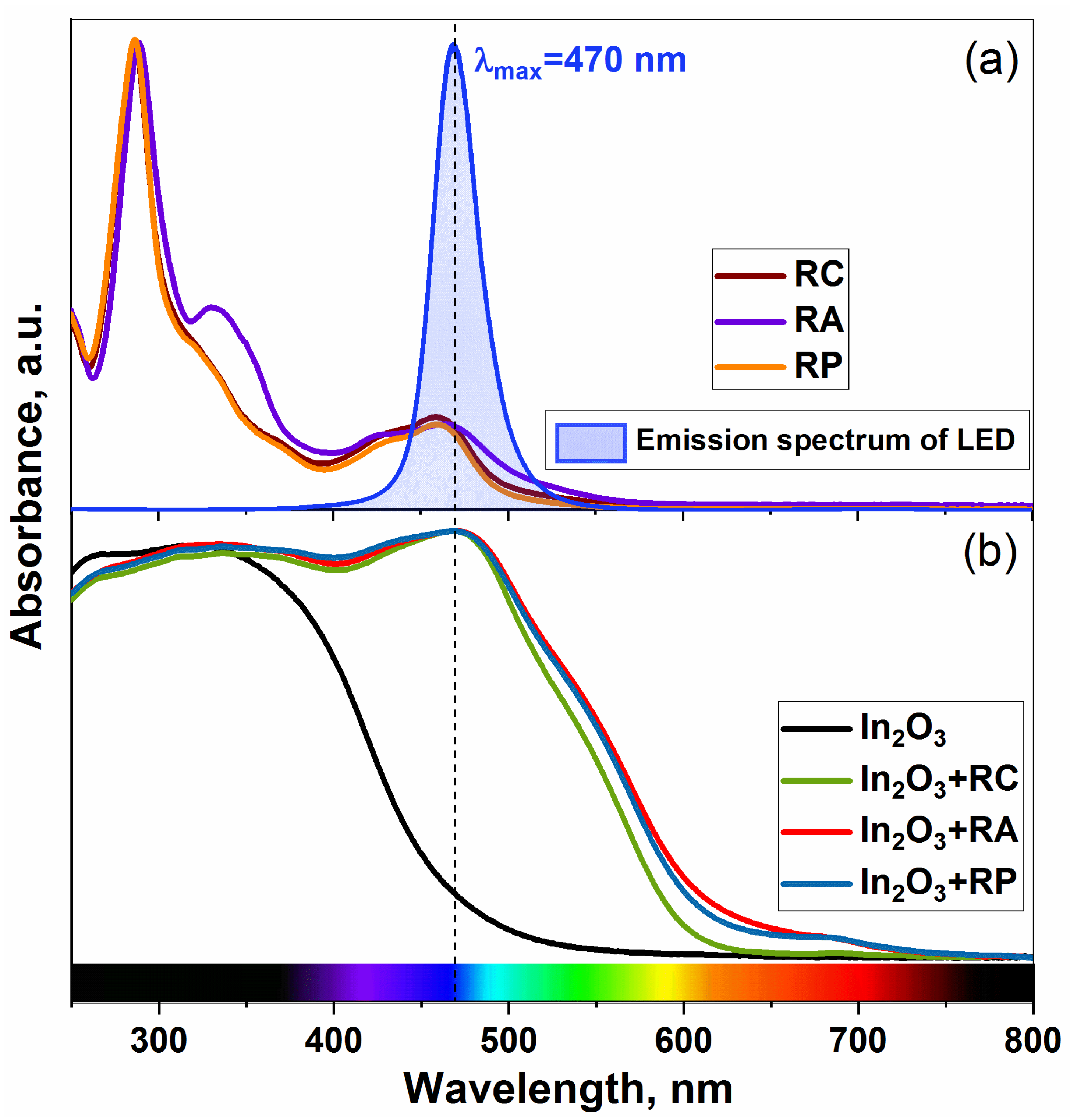
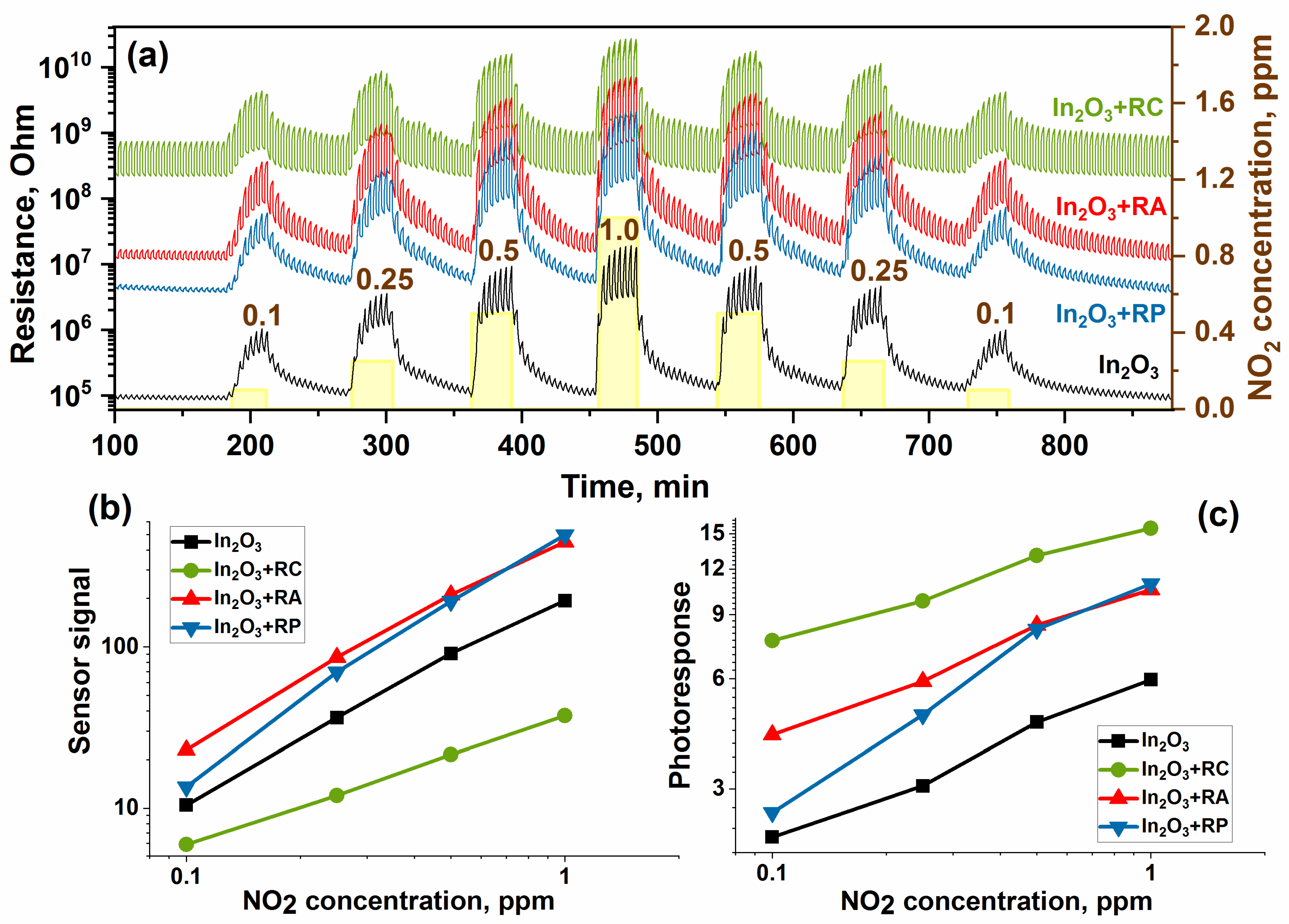
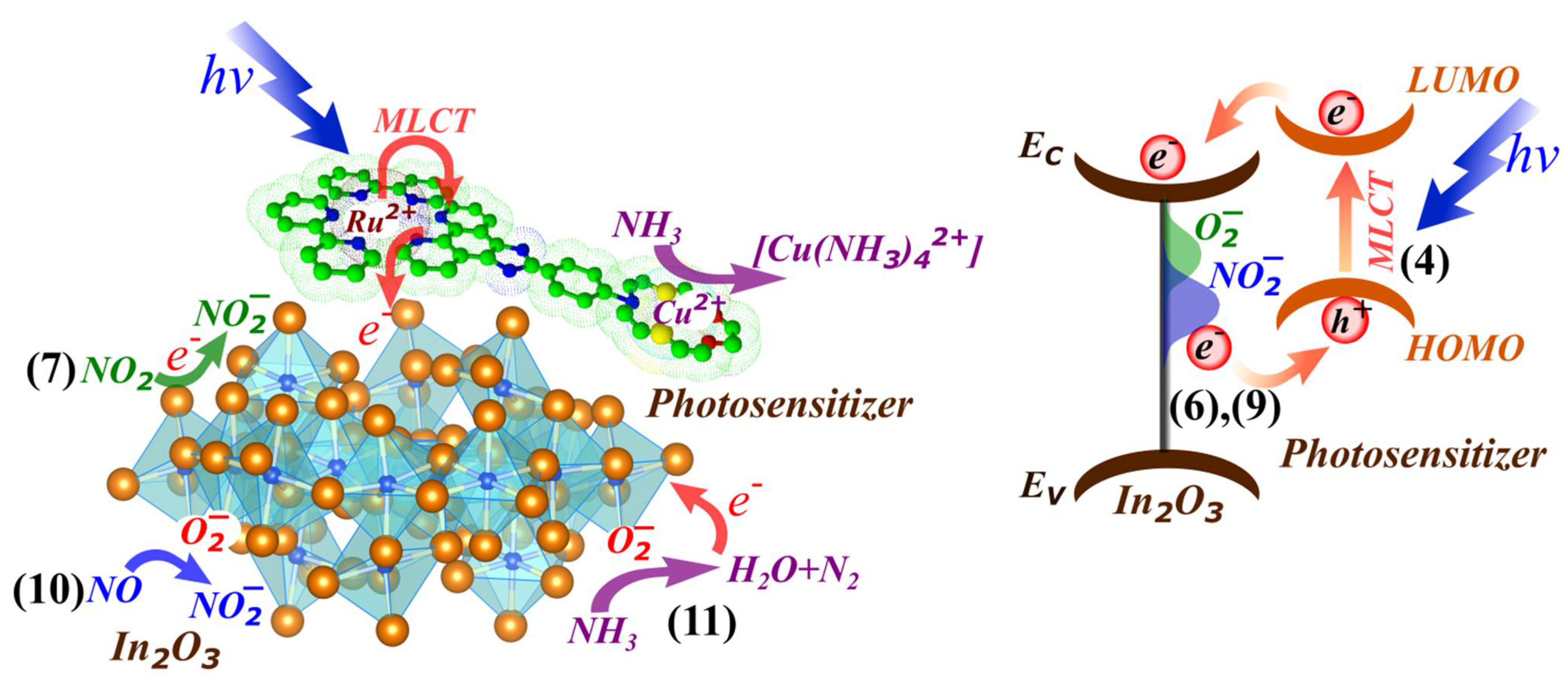

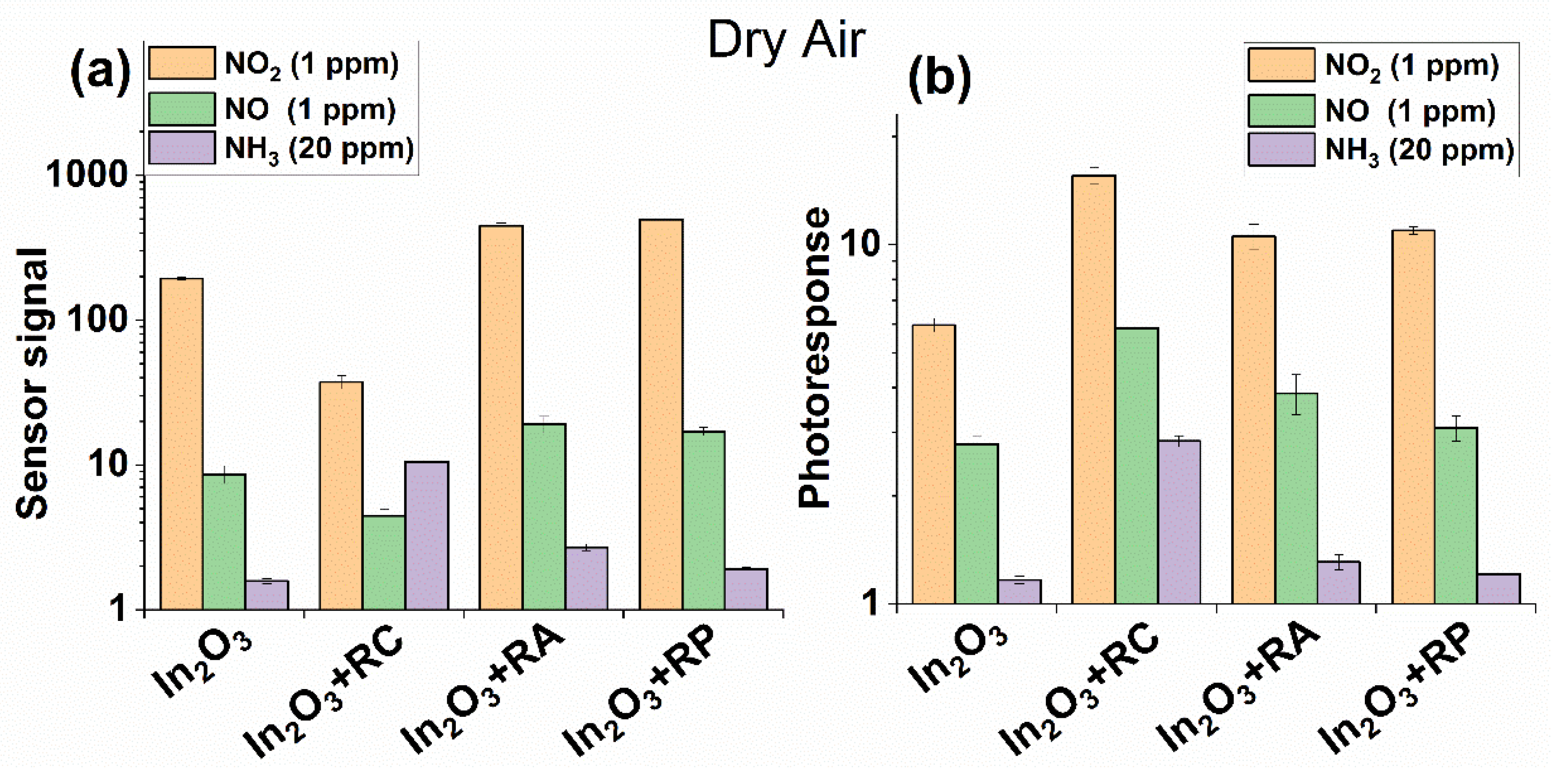
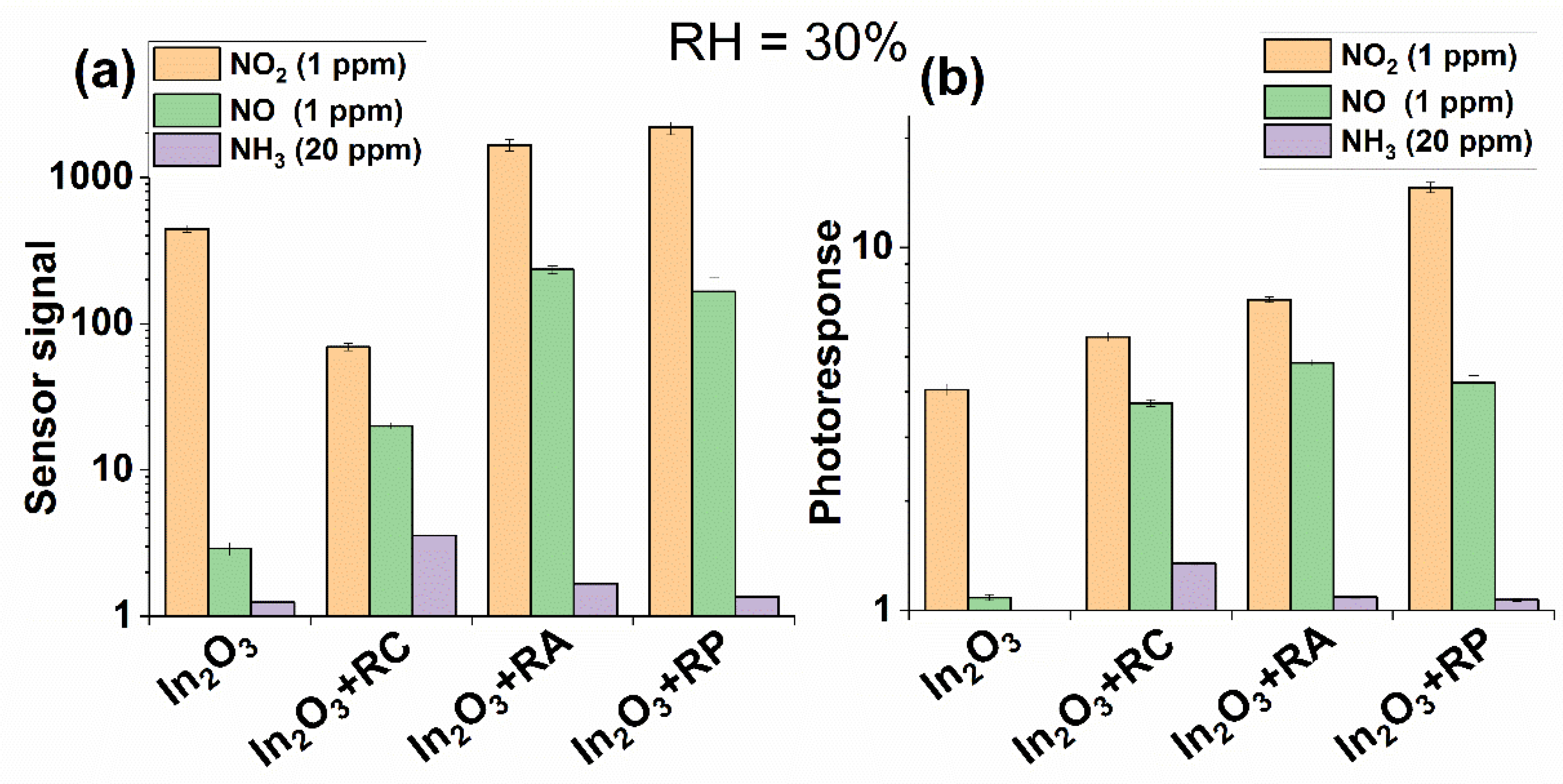

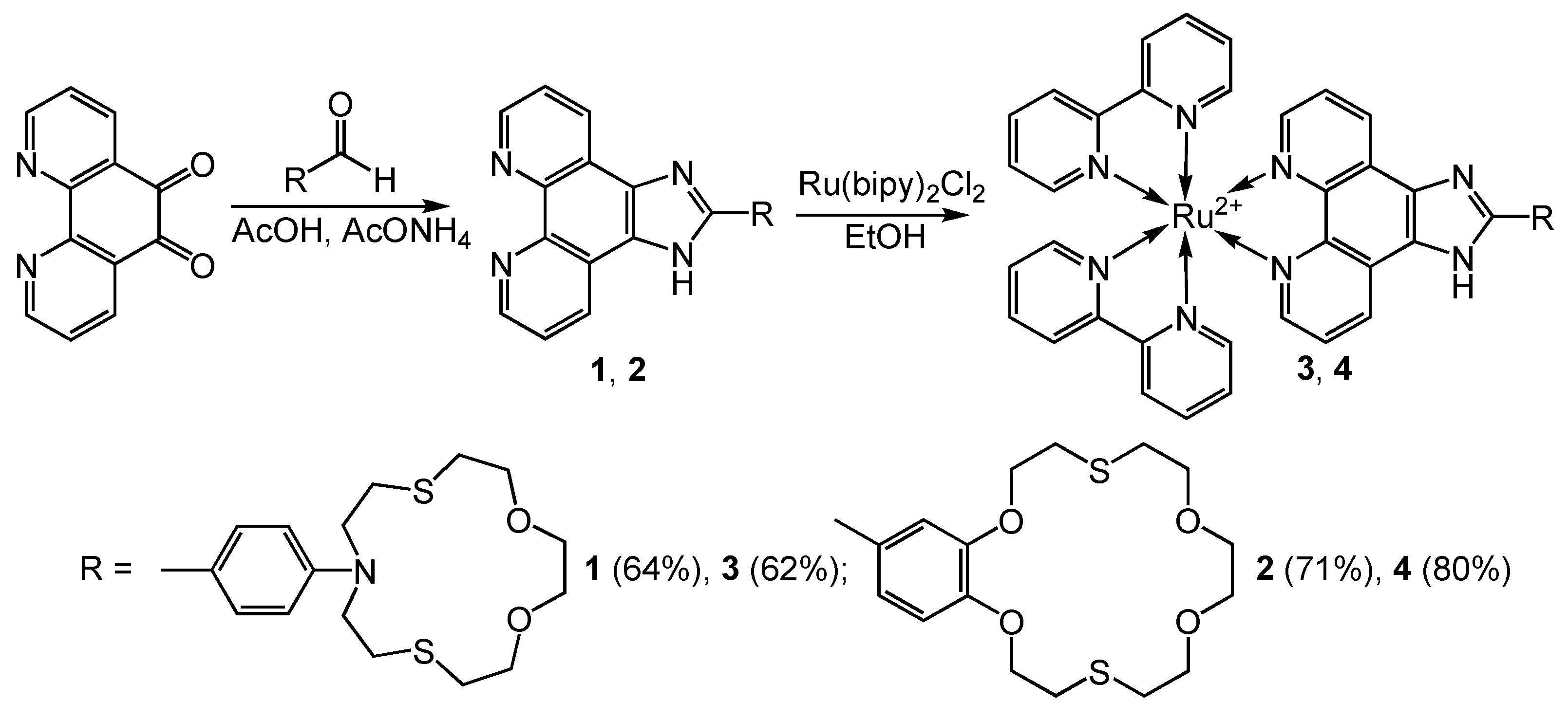

| Sample | [Ru]/([Ru] + [In] + [M] *), mol% | [Cu]/([Ru] + [In] + [M] *), mol% | [Ag]/([Ru] + [In] + [M] *), mol% | [Pb]/([Ru] + [In] + [M] *), mol% |
|---|---|---|---|---|
| In2O3 + RC | 0.68 ± 0.01 | 0.47 ± 0.01 | - | - |
| In2O3 + RA | 0.71 ± 0.01 | - | 0.52 ± 0.01 | - |
| In2O3 + RP | 0.77 ± 0.01 | - | - | 0.57 ± 0.01 |
| Wavenumber, cm−1 | Vibrational Mode |
|---|---|
| 623, 765 | γ (CH), ν (Ru–N) |
| 730 | ρ (CH2), ν (Ru–N) |
| 810 | ν (C–C) |
| 1008 | ν (C-O) |
| 1096 | ν (C-O), δ (CH) + ν (ring) |
| 1260 | ν (C=O) + ν (C=C) + δ (CH) |
| 1355 | ν (C=C) + δ (CH) |
| 1455 | δ (CH) + ν (C=N) |
| 1486 | ν (C–C) |
| 1604 | ν (C=N), ν (C–C) |
| 2863, 2917, 3074 | ν (C-H) |
| 3450 | ν (O-H), ν (N-H) |
| Material | Wavelength, nm | Incident Irradiance, mW/cm2 | Sensing Gas | Concentration, ppm | Sensor Signal, % | Refs. |
|---|---|---|---|---|---|---|
| Sulfur-hyperdoped silicon | White LED | 0.74 | NH3 | 20.0 | 20,100 | [52] |
| WO3 nano-needles | 325 | 0.4 | NH3 | 20.0 | 66.6 | [53] |
| WS2 microflakes | 365 | - | NH3 | 10.0 | 240 | [54] |
| 2DPI/In2O3 composite | 365 | - | NH3 | 10.0 | 950 | [55] |
| CuPc-loaded ZnO nanorods | 600–622 | 0.15 | NH3 | 20.0 | 600 | [29] |
| In2O3/heterobimetallic complex Ru(II)-Cu(II) | 470 | 8.0 | NH3 | 20.0 | 950 | Present study |
| TiOx nanodots | 310 | 0.3 | NO | 10.0 | 31.0 | [56] |
| Au-ZnO nanocomposite | 550 | - | NO | 2.0 | 194 | [57] |
| In2O3 nanostructure | 365 | 3.2 | NO | 2.0 | 1200 | [58] |
| Nano-porous organic diodes | 365 | 40 | NO | 1.0 | 233 | [59] |
| In2O3/Ru(II) heteroleptic complex | 470 | 8.0 | NO | 1.0 | 3000 | [22] |
| In2O3/heterobimetallic complex Ru(II)-Ag(I) | 470 | 8.0 | NO | 1.0 | 1815 | Present study |
| Mesoporous In2O3 | 400 | - | NO2 | 5.0 | 900 | [60] |
| In2O3 | 385 | 1.0 | NO2 | 8.0 | 17,900 | [61] |
| WO3 | 590 | 340 | NO2 | 0.16 | 820 | [62] |
| Au/ZnO | 365 | 1.2 | NO2 | 5.0 | 455 | [63] |
| Al/TiO2/Al2O3/p-Si | 254 | - | NO2 | 20 | 11.5 | [64] |
| ZnS-core/ZnO-shell nanowires | 254 | 1.2 | NO2 | 1.0 | 339 | [65] |
| Bi2O3-core/ZnO-shell nanobelt | 254 | 1.2 | NO2 | 1.0 | 227 | [66] |
| N-719 dye/ZnO hybrid | 480 | 370 | NO2 | 1.25 | 143 | [67] |
| CuO/ZnS nanowire | 365 | 2.2 | NO2 | 5.0 | 955 | [68] |
| CdSe QD@In2O3 | 535 | 20 | NO2 | 1.6 | 106 | [69] |
| CdSe QD@ZnO | 535 | 20 | NO2 | 1.6 | 3000 | [69,70] |
| ZnO/In2O3 composite | 365 | 25 | NO2 | 5 | 221 | [71] |
| Au/MoS2 | 365 | - | NO2 | 2.5 | 30 | [72] |
| ZnO | 455 | 5 | NO2 | 0.025 | 20 | [73] |
| WS2-decorated rGO | 430 | 0.66 | NO2 | 1.0 | 21 | [74] |
| ZnO/(ZnSe(shell) @ CdS(core)) composite | 535 | 20 | NO2 | 2.0 | 6900 | [75] |
| WO3 | 365 | 8 | NO2 | 5.0 | 11,300 | [76] |
| Perylenediimide-sensitized SnO2 | 400–700 | - | NO2 | 0.5 | 12,900 | [77] |
| Polypeptide-assisted ZnO nanorods | 365 | - | NO2 | 10.0 | 400 | [78] |
| Au-ZnO nanorods | 495 | 50 | NO2 | 1.0 | 109 | [79] |
| Ag- ZnO heterostructure | 470 | 75 | NO2 | 1.0 | 150 | [80] |
| MoS2/ZnO nanohybrid | 365 | 0.3 | NO2 | 0.5 | 2310 | [81] |
| ZnO/CsPbBr3 NCs | 470 | 8.0 | NO2 | 2.0 | 30,000 | [82] |
| In2O3–ZnO nanotubes | 365 | 1.95 | NO2 | 0.5 | 3170 | [83] |
| In2O3/Ru(II) heteroleptic complex | 470 | 8.0 | NO2 | 1.0 | 1.75 × 105 | [23] |
| In2O3/heterobimetallic complex Ru(II)-Pb(II) | 470 | 8.0 | NO2 | 1.0 | 49,500 | Present study |
Publisher’s Note: MDPI stays neutral with regard to jurisdictional claims in published maps and institutional affiliations. |
© 2022 by the authors. Licensee MDPI, Basel, Switzerland. This article is an open access article distributed under the terms and conditions of the Creative Commons Attribution (CC BY) license (https://creativecommons.org/licenses/by/4.0/).
Share and Cite
Nasriddinov, A.; Tokarev, S.; Platonov, V.; Botezzatu, A.; Fedorova, O.; Rumyantseva, M.; Fedorov, Y. Heterobimetallic Ru(II)/M (M = Ag+, Cu2+, Pb2+) Complexes as Photosensitizers for Room-Temperature Gas Sensing. Molecules 2022, 27, 5058. https://doi.org/10.3390/molecules27165058
Nasriddinov A, Tokarev S, Platonov V, Botezzatu A, Fedorova O, Rumyantseva M, Fedorov Y. Heterobimetallic Ru(II)/M (M = Ag+, Cu2+, Pb2+) Complexes as Photosensitizers for Room-Temperature Gas Sensing. Molecules. 2022; 27(16):5058. https://doi.org/10.3390/molecules27165058
Chicago/Turabian StyleNasriddinov, Abulkosim, Sergey Tokarev, Vadim Platonov, Anatoly Botezzatu, Olga Fedorova, Marina Rumyantseva, and Yuri Fedorov. 2022. "Heterobimetallic Ru(II)/M (M = Ag+, Cu2+, Pb2+) Complexes as Photosensitizers for Room-Temperature Gas Sensing" Molecules 27, no. 16: 5058. https://doi.org/10.3390/molecules27165058
APA StyleNasriddinov, A., Tokarev, S., Platonov, V., Botezzatu, A., Fedorova, O., Rumyantseva, M., & Fedorov, Y. (2022). Heterobimetallic Ru(II)/M (M = Ag+, Cu2+, Pb2+) Complexes as Photosensitizers for Room-Temperature Gas Sensing. Molecules, 27(16), 5058. https://doi.org/10.3390/molecules27165058









